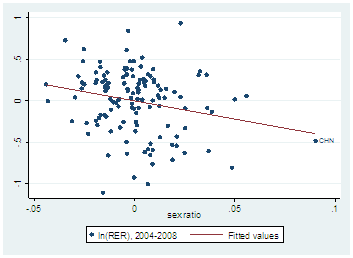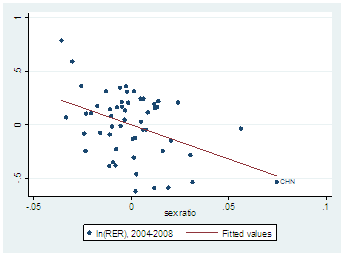From a paper (Ungated/Scribed version here) by Shang-Jin Wei and Qingyuan Du:
China and several other economies in Asia are experiencing an increasingly more severe relative
surplus of men in the pre-marital age cohort. While the existing literature on the sex ratio has examined
its social impact such as crime, we aim to explore neglected implications of the sex ratio imbalance for
the real exchange rate. …
… Real exchange rate undervaluation due to currency manipulation is a frequent
topic in international economic policy discussions. Two commonly used criteria by researchers and
international financial institutions for judging undervaluations are deviations from the purchasing
power parity (PPP) and large and persistent current account surpluses. The goal of this paper is
to demonstrate that a rise in the sex ratio can generate both phenomena. In other words, a low
real exchange rate need not be the cause of a current account surplus. (Given a current account
surplus, foreign exchange reserve accumulation could be a passive outcome of a country’s capital
account controls, rather than exchange rate interventions. In other words, if a country has no capital
controls, e.g., Japan, a current account surplus shows up as an addition to its private sector’s holding of
foreign assets. With capital controls, which typically require compulsory surrender of foreign exchange
earnings by firms or households, a current account surplus has to be converted into additional holding
of foreign exchange reserves by the official sector.)
We highlight two channels through which a sex ratio imbalance could lead to an appearance of
currency undervaluation. The first is a savings channel. If an economy experiences a shock that raises
its savings rate, then the real exchange rate often falls. To see this, we recognize that a rise in the
savings rate implies a reduction in the demand for both tradable and non-tradable goods. Since the
price of the tradable good is tied down by the world market, this translates into a reduction in the
relative price of the nontradable good, and hence a decline in the value of the real exchange rate (a
departure from the PPP). The effect can be persistent if there are frictions that impede the reallocation
of factors between the tradable and nontradable sectors.…
The second theoretical channel works through e¤ective labor supply. A rise in the sex ratio
can also motivate men to cut down leisure and increase labor supply. This leads to an increase in the
economy-wide e¤ective labor supply. If the nontradable sector is more labor intensive than the tradable
sector, this generates a Rybzinsky-like e¤ect, leading to an expansion of the nontradable sector at the
expense of the tradable sector. The increase in the supply of nontradable good leads to an additional
decline in the relative price of nontradable and a further decline in the value of the RER. There is
evidence from China that the effective labor supply is indeed larger in regions with a higher sex ratio
(Wei and Zhang, 2010).
Putting the two channels together, a rise in the sex ratio generates a real exchange rate that
appears too low relative to the purchasing power parity. Of course, if there are structural factors,
other than a rise in the sex ratio, that have also triggered an increase in the aggregate savings rate
(e.g., an increase in the government savings rate) or an increase in the e¤ective labor supply (e.g.,
peculiar patterns of the rural-urban migration within a country), they would reinforce the mechanisms
discussed in this paper, causing the real exchange rate to fall further.
…
The authors develop a theoretical model to explain the two channels. As someone empirically oriented, the key issue for me is the strength of the relationship. The authors present a series of regressions demonstrating the strength of the correlations (see Table 2 and 3 for the (log) real exchange rate, and Tables 4 and 5 for the current account), but for me it’s easiest to see the relationship graphically. Figure 2 presents the scatterplot after controlling for other critical factors (this graph and the succeeding one are not in the paper; thanks to Shang-Jin for generating them):

Figure 1: ln(RER) vs sex ratio, averaged over 2004-2008, conditional on ln(GDP per capita) and financial development (private credit/GDP). Slope= -4.38, t-statistics= -2.64. If China is removed from the sample, the t-statistics on the sex ratio becomes -2.30.
The strength and nature of the correlation remains much unchanged if additional controls are used.

Figure 2: ln(RER) vs sex ratio, averaged over 2004-2008 conditional on ln(GDP per capita) and financial development (index for financial system sophistication from Global Competitiveness Report). Slope= -6.30, t-statistics= -3.21. If China is removed from the sample, the t-statistics on the sex ratio becomes -2.30.
The authors conclude:
If other factors, in addition to a rise in the sex ratio, have also contributed to a rise in the
Chinese savings rate, such as a reduction in the dependency ratio, or a rise in the corporate and
government savings rates, they can complement the sex ratio effect and reinforce an appearance of an
undervalued currency even when there is no manipulation. To be clear, this paper is not saying that
no manipulations have occured. Instead, it illustrates potential pitfalls in assessing the equilibrium
exchange rate when important structural factors are not accounted for.
Empirically, countries with a high sex ratio do appear to have a low value of the real exchange
rate and a current account surplus. If we take the econometric point estimates at face value, it appears
that the Chinese real exchange rate has only a relatively small amount of undervaluation (2-8%) once
we take into account the sex ratio effect and other structural factors.
The paper is available here; and the related paper on current account balances is here.
OT:
Price of oil comes down a bit, and so does initial unemployment claims…
Menzie, in the excerpt of the paper shown here, I only saw one channel discussed. What is the second? Maybe I missed something. Thanks
MDueker: Apologies, I was being too concise. I included two more paragraphs, which then includes the description of the second channel. Thanks for the heads-up.
In all crime,look for the woman.
No offense intended, but I’m surprised to see this sort of analysis reported in this blog.
You may want to talk to Jim about what happens when you regress a unit root process like sex ratios on another unit root process like real exchange rates. The topic is cute, as is the “theory”, but it seems pretty spurious to me.
It seems a bit ironic that the authors discuss a manipulation-free context for a low real exchange rate that includes mandatory surrender of foreign-exchange earnings to the central bank. That sounds like a form of currency manipulation to me.
I am unpersuaded by their causative model, but I don’t have time to go through the data. I didn’t see that they considered the opposite might have more of an effect: more girls would increase the savings rate – especially given marriage traditions in China. I am not convinced they explain why their perspective is meaningful. I have a similar reservation about the 2nd “channel.”
I don’t keep data like this at my fingertips but my understanding is that consumption is increasing, driven in part by the excess of men, that savings rates have decreased – but are very hard to measure – and that one can argue about the leisure versus labor point they make.
@Anonymous
I think the point here is that China’s sex ratio is not a unit root; the one-child policy has caused an unnaturally high sex ratio.
“I think the point here is that China’s sex ratio is not a unit root; the one-child policy has caused an unnaturally high sex ratio.”
Okay, I admit I hadn’t looked at the data prior to that comment. Now that I look at the data, I’m fairly shocked.
Sorry, Menzie.
“I think the point here is that China’s sex ratio is not a unit root; the one-child policy has caused an unnaturally high sex ratio.”
OK, so what?
To come to the conclusions drawn from this analysis stereotypes have to be assumed as to the behavior of each sex.
This is the most bigoted post I have seen on an economics site. It is begotry itself when leftists and collectivists condemn bigotry in others but feel free to engage in bigotry themselves.
Thanks Menzie for sharing the Shang-Jin and Qingyuan paper. It made interesting reading. From my perspective, it makes perfectly good sense that increased competition for females would result in greater efforts by males to accumulate wealth and status.
“If China is removed from the sample, the t-statistics on the sex ratio becomes -2.30.”
What about removing other countries with large official intervention in exchange rate markets? That would make the results more convincing.